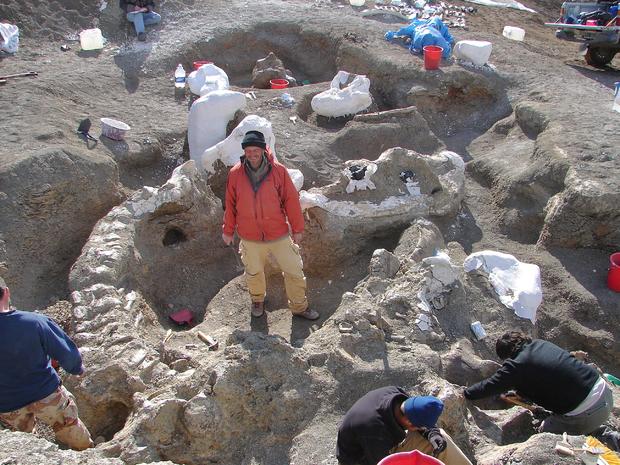"Astoundingly huge" dinosaur find gets a downgrade
Last year, scientists announced the discovery of a previously unknown dinosaur species that was thought to be one of the largest land animals to ever walk the Earth. But a new report published today in the Royal Society journal Biology Letters suggests it may not have been so big after all.
The skeleton of the Dreadnoughtus was unearthed by paleontologists in Patagonia, Argentina. Unlike most ancient fossils, it had almost all of its major bones intact, allowing scientists to measure its overall size, estimated to be 85 feet long and weighing as much as 65 tons. What's more, they believed it had not yet finished growing.
Originally, the scientists used a scaling equation based on the size of the thigh and forearm bones to calculate the dinosaur's colossal body mass.
But researchers from the University of Liverpool reevaluated this estimate after studying other sauropod dinosaurs, which are only slightly smaller in size than the Dreadnoughtus and are believed to weigh significantly less than 60 tons.
Dr. Karl Bates and his research team used a three-dimensional skeletal modeling method to study the body mass of the giant dinosaur. The technique involves mathematically reconstructing a "skin" volume around the dinosaur's bones on a computer. This skin outline is then expanded to account for the size of muscle, fat, and other tissues. The model included a data set from other species, both living and dead, "in order to quantify how much, on average, it was necessary to expand our minimum skeletal volumes by to reach the real body mass of the animals," Bates explained to CBS News.
The results of this method showed that the Dreadnoughtus more likely weighed between 30 and 40 tons, much less than originally thought.
"Both the scaling equation method and our modeling approach produce a range of mass estimates," Bates said. "So the methods produce overlapping predictions, but our range is much smaller and suggests that only the lower end estimates produced by the scaling equation are plausible. We found a similar result for the other two sauropod dinosaurs we modeled."
But not everyone agrees with Bates's new estimates. Kenneth Lacovara of Drexel University in Philadelphia, who led the team that originally discovered the Dreadnoughtus, questioned the method the researchers of the new study used.
"No one knows whether dinosaur bodies were particularly fat, particularly skinny or somewhere in between," he told Live Science. "Also, very little is definitively known about the respiratory system of sauropods. Therefore, no one knows how much volume should be subtracted for the lungs [and] any system of air sacs."
He added that if the Dreadnoughtus weighed less than originally estimated, it wouldn't have needed those massive legs to support its body.
"Biomechanists agree that animals essentially have the limbs that they need in terms of weight-bearing capacity," Lacovara said. "In other words, there is no reason to suppose that the limbs of Dreadnoughtus were overbuilt. Proposing that an animal has anomalously huge limbs compared to its mass requires an evolutionary explanation that the authors do not provide."


